Gonfaloniere of the Church

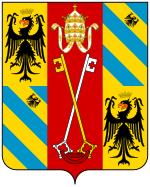
The Gonfaloniere the Church or Pontifical gonfalonier ( Italian Gonfaloniere della Chiesa , German , standard-bearer ' , latin vexillifer Ecclesiae ) was a military and political office of the Papal States . It arose from the use of the papal banner during the battle. The office later became largely ceremonial and political. When he was nominated, the Gonfaloniere was awarded two banners, one with the coat of arms of the church (Vexillum cum armis Ecclesiae) and another with the coat of arms of the ruling Pope (cum suis armis) . The Gonfaloniere was entitled to wear ecclesiastical emblems (including the keys of St. Peter and the Padiglione ) on his own arms, usually only during his term of office, but permanently on occasion. Innocent XII. abolished both offices and replaced them with the office of the standard bearer of the Holy Roman Church ( Italian : Vessilifero Romana Chiesa di Santo ), which was later conferred hereditary on the Naro Patrizi family.
List of gonfaloniers of the Church (incomplete)
| Term of office | portrait | Gonfaloniere | appointing Pope | Remarks |
|---|---|---|---|---|
| circa 1296 |

|
James II of Aragon |
Boniface VIII (1294-1303) |
King of Aragon and Valencia ; Gonfalonier, Admiral, and Captain General of the Church ; appointed to encourage him to wage war against his brother, Frederick II (see Sicilian Vespers ) |
| 1372–? | Galeotto I. Malatesta |
Gregory XI. (1370-1378) |
Commander of the papal army against Bernabò Visconti , whom he defeated at Montechiaro | |
| 1377-1384 | Ridolfo II da Varano di Camerino |
Gregory XI. (1370-1378) |
served as the commander of the papal army in the final years of the Avignon papacy | |
| 1384-1385 |

|
Charles III from Naples |
Urban VI. (1378-1389) |
King of Naples , excommunicated and removed from office; his forces besieged the pope in Nocera, while the Pope later tried Naples for his nephew Francesco Mori Cotti Prignani usurp |
| 1387–? | Carlo I. Malatesta |
Urban VI. (1378-1389) |
a condottiere | |
| circa 1399 |

|
Martin I of Aragon | Antipope Benedict XIII. |
King of Aragon and Sicily, Gonfaloniere of the western antipope , refused to wage war against France during the siege of Avignon |
| 1403–? | Niccolò III. d'Este |
Boniface IX (1389-1404) |
a condottiere , also lord of Ferrara; appointed as opposed to Milan; possibly reappointed by Pope Martin V. | |
| 1406–? |

|
Ladislaus of Naples |
Innocent VII (1404-1406) |
King of Naples; Appointed for his help in helping Innocent VII against the Roman mob; sent to Roccasecca in 1411 , he left Pope Gregory XII. in favor of the antipope John XXIII. who made him his gonfalonier |
| 1409-1411 |
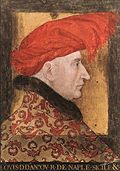
|
Ludwig II of Anjou | Antipope Alexander V. |
in contrast to Ladislaus for the Kingdom of Naples; was appointed Gonfalonier by the Pisan faction of antipope Alexander V; although he won an important victory at Roccasecca, he left the field and returned to France |
| 1412–? |
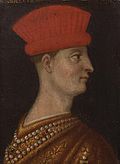
|
Gianfrancesco I. Gonzaga |
Gregory XII. (1406-1415) |
a condottiere ; also Lord of Mantua |
| 1419–? | Guidantonio da Montefeltro |
Martin V (1417-1431) |
a condottiere ; also Herr von Urbino | |
| 1431–? | Niccolò Fortebraccio |
Eugene IV. (1431-1447) |
a condottiere ; despite his failure to recapture Città di Castello, he was obliged as a Gonfaloniere to oppose Sigismund of Luxembourg in Tuscany and the Prefetti di Vico in the Lazio region, but used his position to promote his own interests, after which he moved to the War against the Papal States for the Duchy of Milan | |
| 1433-1434 | Giovanni Vitelleschi |
Eugene IV. (1431-1447) |
for a short time under Pope Eugene IV. Commander of the papal troops | |
| 1434-1442 |

|
Francesco I. Sforza |
Eugene IV. (1431-1447) |
a condottiere ; while working for Milan he received the position of gonfaloniere together with Ancona under the terms of a peace with Eugene, then led the campaign against the former gonfalonier and his former ally Niccolò Fortebraccio. Losing his position against him after the alliance of Milan with the papacy. |
| 1442–? |
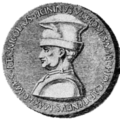
|
Niccolò Piccinino |
Eugene IV. (1431-1447) |
a condottiere ; originally he helped Fortebraccio and Sforza against the papacy; appointed Gonfalonier to conquer Sforza's possessions in the Marca anconitana |
| 1444–? |

|
Louis XI. from France |
Eugene IV. (1431-1447) |
appointed for his actions in Switzerland against the Council of Basel and the antipope Felix V. |
| circa 1455 | Francesco I. Sforza | second term; undisputed Duke of Milan | ||
| ? -1458 | Pedro Luis Borgia |
Calixt III. (1455-1458) |
Pope Kalixt's older brother, also Captain General of the Church and Duke of Spoleto | |
| 1462-1468 |
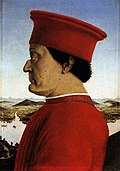
|
Federico da Montefeltro |
Pius II (1458-1464) |
a condottiere , also Duke of Urbino ; called against Sigismondo Malatesta , Lord of Rimini; reappointed by Pope Paul II against Venice |
| 1474–? | Federico da Montefeltro |
Sixtus IV. (1471-1484) |
second term, now as Duke of Urbino; married his daughter to Pope Sixtus' favorite nephew Giovanni della Rovere , who inherited the duchy after the death of Federico's son Guidobaldo | |
| 1496-1497 |

|
Giovanni Borgia |
Alexander VI. (1492–1503) |
Son of Alexander VI, also Duke of Gandia and captain general; murdered, perhaps by his brother Cesare |
| March 29, 1500-1503 |

|
Cesare Borgia |
Alexander VI. (1492–1503) |
Son of Alexander VI .; former cardinal, also Duke of Valentino and captain general; often accused of murdering Giovanni, either directly or indirectly; Julius II refused to confirm his election |
| 1504–1508? |

|
Guidobaldo da Montefeltro |
Julius II (1503-1513) |
a condottiere , also Duke of Urbino ; Son of Federico da Montefeltro; adopted Francesco Maria I della Rovere , nephew of both himself and the Pope |
| April 19, 1509-1510 |

|
Alfonso I. d'Este |
Julius II (1503-1513) |
also Duke of Ferrara; commanded the forces against Venice in the second phase of the War of the League of Cambrai ; Removed from his post and excommunicated with his entire family in order to allow Ferrara to return under papal administration |
| September 30, 1510–? |

|
Gianfrancesco II Gonzaga |
Julius II (1503-1513) |
also Margrave of Mantua |
| 1513-1516 |
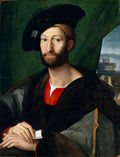
|
Giuliano di Lorenzo de 'Medici |
Leo X. (1513-1521) |
also Captain General of the Church and Duke of Nemours |
| 1516–? |
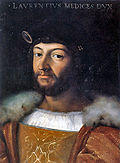
|
Lorenzo di Piero de 'Medici |
Leo X. (1513-1521) |
also captain general of the church; commanded the papal army in the War of Urbino (1517) before he was wounded during the siege of Mondolfo |
| 1519–? |

|
Federico II Gonzaga |
Leo X. (1513-1521) |
also Duke of Mantua and Captain General of the Church and the Republic of Venice ; was not obliged against the Holy Roman Empire and failed to intervene in the Sacco di Roma |
| February 1, 1537-1547 |
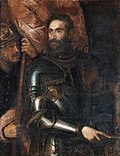
|
Pier Luigi Farnese |
Paul III (1534-1549) |
Son of Paul III; also Duke of Parma, Piacenza and Castro |
| 1547-1551 |

|
Ottavio Farnese |
Paul III (1534-1549) |
Son of Pier Luigi Farneses, also Duke of Parma, Piacenza and Castro |
| circa 1565 | Jacob Hannibal from Ems zu Hohenems | (or Count Hannibal von Altemps) | ||
| 1566–? |

|
Ottavio Farnese |
Pius V (1566–1572) |
second term |
| 1572-1585 |
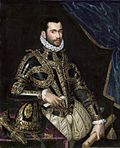
|
Giacomo Boncompagni |
Gregory XIII. (1572–1585) |
Son of Gregory XIII; also captain general of the Spanish Milan, acquired the duchies of Sora and Arce, Aquino and Arpino; removed from office after the election of Pope Sixtus V. |
| approx. 1621–? |

|
Odoardo I. Farnese |
Gregory XV. (1621-1623) |
also Duke of Parma and Piacenza ; Pope Urban VIII excommunicated him and forbade him to use the coat of arms of the Gonfalonier |
| ? -1630 | Carlo Barberini |
Urban VIII. (1623-1644) |
Brother of Pope Urban VIII and Antonio Marcello Barberini , father of Taddeo Barberini | |
| 1630–1636 (?) |
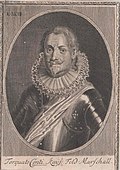
|
Torquato Conti |
Urban VIII. (1623-1644) |
Duke of Guadagnolo and Field Marshal of the Holy Roman Empire |
| 1639-1644 |

|
Taddeo Barberini |
Urban VIII. (1623-1644) |
Nephew of Pope Urban VIII and Prince of Palestrina . Appointed commander of the papal army in the Castro Wars. In 1644, after the election of Pope Innocent X, went into exile and died in 1647 without returning to Rome. Dates are approximate. |
| 1649–? |
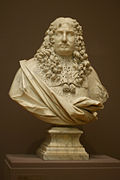
|
Maffeo Barberini |
Innocent X (1644–1655) |
Son of Taddeo Barberini , who received his father's earlier titles after reconciliation with the Pamphili and Barberini families. |
See also
Individual evidence
- ^ A b c Philippe Levillain: The Papacy: An Encyclopedia. “Heraldry.” Retrieved June 5, 2010.
- ↑ Pope Boniface VIII . In: Catholic Encyclopedia , 1913 (English)
- ^ Welbore Baddeley: Charles III of Naples and Urban VI . Retrieved June 5, 2010.
- ^ HJ Chaytor: A History of Aragon and Catalonia. Retrieved June 5, 2010.
- ↑ Lodovico Antonio Muratori: Annali d'Italia ed altre opere varie: Dall'anno 1358 all'anno 1687 , Vol. IV. Accessed June 5, 2010.
- ^ Catholic Encyclopedia. "Antipope John XXIII." Retrieved June 5, 2010.
- ^ Encyclopædia Britannica , 1911. Alexander V. Retrieved June 5, 2010.
- ^ Niccolò Machiavelli: History of Florence . Retrieved June 5, 2010.
- ↑ Cecilia M. Ady: A History Of Milan Under The Sforza . Retrieved June 5, 2010.
- ^ Giorgio Vasari: Lives of the Most Eminent Painters Sculptors and Architects , Vol. III. Retrieved June 5, 2010.
- ^ A b c Raphael Sabatini: The Life of Cesare Borgia. Retrieved June 5, 2010.
- ↑ Adrian Mourby: The Independent . In search of: Federico in Urbino. November 13, 2001. Retrieved June 5, 2010.
- ^ A b c John Sloan: Dukes of Urbino. ( Memento of the original from May 9, 2012 in the Internet Archive ) Info: The archive link was inserted automatically and has not yet been checked. Please check the original and archive link according to the instructions and then remove this notice. Retrieved June 5, 2005.
- ↑ Spinosa: La saga dei Borgia .
- ^ Eliakim Littell: Making of America Project : The Living Age. (PDF) 1888.
- ↑ Borgia . (PDF) In: Chambers's Encyclopædia: A Dictionary of Universal Knowledge . 1901.
- ^ The New Encyclopædia Britannica . 1983.
- ^ JD Passavant: Rafael of Urbino and his Father, Giovanni Santi. Op. cit. The National Quarterly Review . Retrieved June 5, 2010.
- ^ John Julian Norwich: History of Venice . Pp. 401-402.
- ^ A b William Roscoe: The life and pontificate of Leo the Tenth, Vol. II. Retrieved June 5, 2010.
- ↑ a b c Giacomo Bascapè u. a .: Insegne e Simboli, Araldica Pubblica e Privata Medievale e Moderna. Ministero per i beni culturali e ambientali, Rome 1983. Op. cit. “Heraldry in Pre-Unification Italy.” Retrieved June 5, 2010.
- ^ John A. Symonds: Sketches and Studies in Italy and Greece. Retrieved June 5, 2010.
- ↑ Kenneth M. Setton: The Papacy and the Levant (1204-1574). Vol. III. The Sixteenth Century to the Reign of Julius III.
- ↑ Christopher Hare et al. a .: Courts & Camps of the Italian Renaissance. (PDF) 1908.
- ↑ Lodovico Antonio Muratori: Annali d'Italia dal principio dell'era volgare sino all'anno MDCCXLIX , Vol. XIV. Retrieved June 5, 2010.
- ^ Allan J. Crosby (Ed.): Calendar of State Papers, Foreign: Elizabeth. Vol. 8 (1566-1568). "Elizabeth: February 1566." Retrieved June 5, 2010.